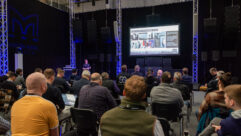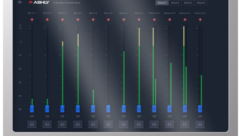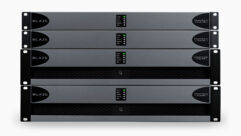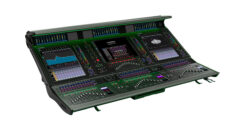
The Audio Zone
Aug 17, 2012 11:02 AM
Networked audio for a mood-sensitive room at Envy Nightclub.

As a former Broadway engineer (Les Miz, Phantom, Sunset Blvd.) turned AV designer, Nathan Powell thinks a lot about the audience. Whether in a church, a nightclub, or restaurant, he knows audio can facilitate the natural human tendency to come together and share an experience.
As president and owner of PTC Group (Production Technology Consultants Group), based outside Philadelphia, he is committed to zoned audio; in the last few years he’s started to apply his conviction to networked audio for mood-sensitive rooms.
For the Envy nightclub at the Route 66 Casino Hotel in Albequerque, Powell got the chance to dramatically transform the guest experience. In its previous incarnation, the nightclub was open to the casino, something that didn’t work for the guests or the business. When the owner committed to essentially starting from scratch with an enclosed building (including a strategically enclosed VIP patio) the stage was set for Powell to do his work and build a 100 percent digital, zoned network around a BSS Soundweb London hub.

The network distributes the FOH mixer, the DJ mixer, to Crown MAi series amplifiers, which playback through an enviable (no pun intended) collection of JBL speakers—including the new Marquis Dance Club series, along with VerTec line arrays, AE, and Control Contractor series speakers.
The performance-based club attracts both A-list Latino dance bands and elite DJs; “The owner was willing to go for the best, which at this moment in time is the JBL Marquis Dance,” Powell says.
So the bones of a great experience were there—great amps, great speakers, new architecture, top shelf talent. Now all Envy needed was a great network, one that could be controlled during performances to adjust the sound (plus lighting and environment) to facilitate whatever mini party was shaping up in the various zones. “The more low end, crisp audio you can get into the party atmosphere—that literally translates to dollars for the owner in terms of how long people stay and how much food and drink they consume,” he says. Powell says the owner understood the investment.
A longtime BSS Soundweb London user, Powell says that some relatively recent products gave him the chance to take this network to a new level. First for digital I/O, Envy became the first multi-functional performance venue to use Aviom’s AllFrame Multi-modular I/O system. The AllFrame products were added to Aviom’s Pro64 product line approximately a year ago. Powell was mindful about using new technology in such a high-profile installation, so he spent a lot of time testing the Pro64 system in PTC’s facility in Reading, Pa., and at the Aviom factory in West Chester, Pa., before including it in his system design. “When I did my testing, the AllFrame mic preamps (the C4m mic/ line input cards) were very impressive,” he says
Based on the same A-Net protocol and technology principles as the rest of the Pro64 series product line, the AllFrame offers a modular approach to building a system. The heart of the AllFrame system, the F6 Modular I/O Frame—which can be mounted in or on a wall, rack mounted, or made into a stage box—can be configured with up to six I/O cards per frame, allowing simple field configuration, as well as the most efficient use of network and hardware resources. And it was for this reason in part that Powell chose it for Envy.
The casino chose a Yamaha M7CL as the house console, which works readily with Aviom’s Pro64 products. The AllFrame stage units are fitted with four C4m mic/line input cards for a total of 16 local inputs and two C4o analog output cards for eight local outputs. In the sound booth, the club’s Yamaha M7CL console has two 6416Y2 A-Net interface cards installed to send and receive up to 32 channels of audio. The system was designed as a daisychain with the console in the middle of the chain between the two AllFrames, so the layout of the system is very much like the analog equivalent.
Despite the fact that it is similar in design to an analog system, John Neill, the sound engineer at Envy, says, “It’s great to finally have a digital signal path from the stage all the way to the processors.”
One advantage of this digital signal path is that Neill can use Aviom’s Pro64 Network Manager to manage and control the Pro64 audio network. This free software makes it possible to view the network at a glance; control mic preamps from a central location: store, recall, and manage network scenes and device-level presets; and matrix crosspoint switching of inputs and outputs at every audio I/O device.
The other recent technical tool that made the Envy job work so well, Powell says, is a Crestron iPad that gives the audio and lighting techs control over audio, lighting, and environment (temperature). They can roam the club during performances tweaking the room to suit, where and how the mood develops.










